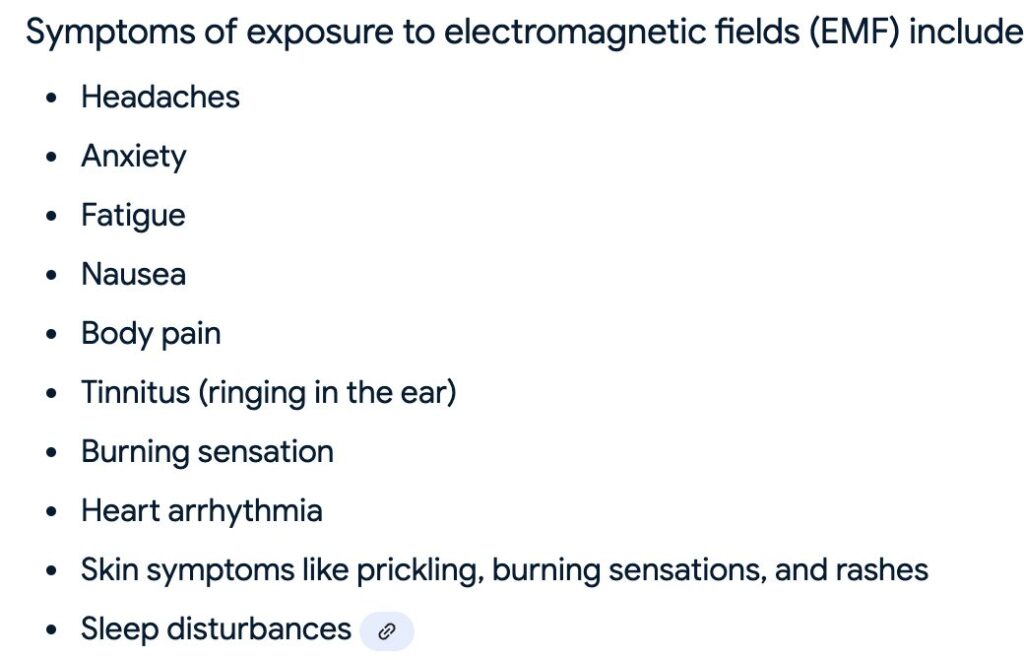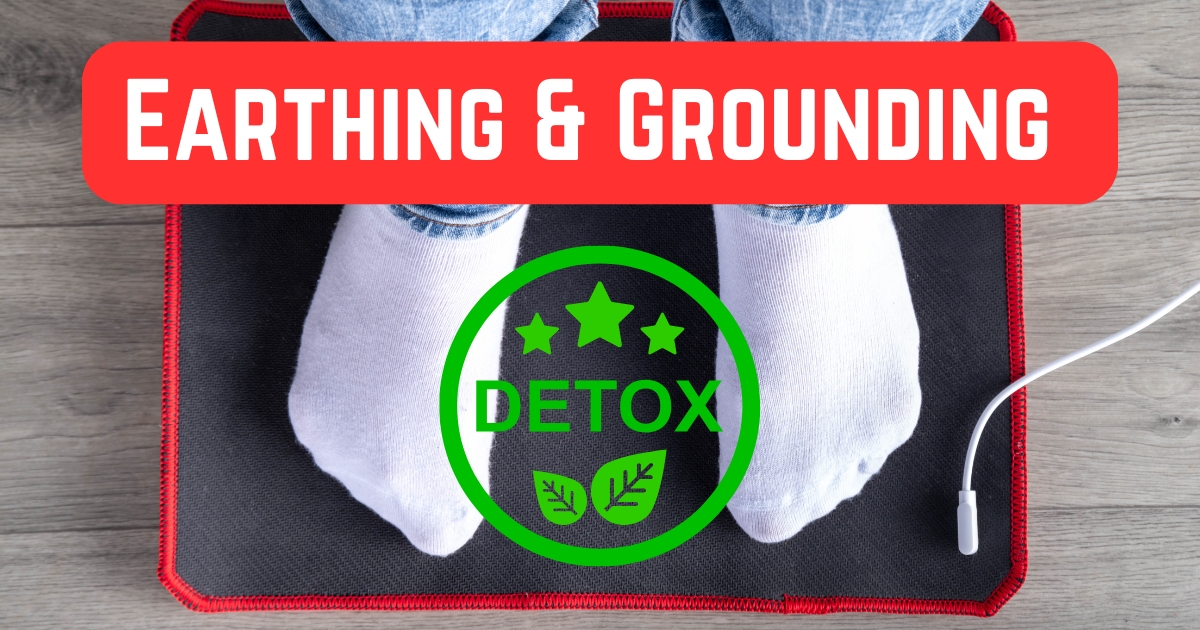What is earthing and grounding detox? Some people who use outlet-based grounding devices have been experiencing various illnesses, including stomach pains, muscle aches, cramps, headaches, and a general feeling of being unwell. These symptoms, similar to EMF toxicity symptoms, have sparked a lot of discussion, and I want to dive into what’s really happening and how to address it.

For those new to earthing and grounding, let me explain briefly. Earthing involves connecting to the Earth’s natural electrical energy, often through walking barefoot on the Earth or using grounding products like mats and sheets. The idea is to reduce body voltage and counteract the effects of electromagnetic fields (EMFs) from modern electronics. If you want a more detailed explanation, check out my article where I discuss 13 research papers on the benefits of earthing and grounding, along with the scientific basis behind it. Also, feel free to join our Facebook group, where I’m one of the admins and a team of experienced moderators. The group has grown to 45,000 members and counting, and we share tips and experiences about earthing and grounding.
Let’s address the issue at hand. Some people who use outlet-based grounding devices have reported adverse symptoms. These include stomach cramps, headaches, muscle pain, and even insomnia. In the earthing community, these symptoms are often referred to as detox or “herxing,” which stands for the Herxheimer reaction—a temporary worsening of symptoms as the body detoxifies. However, I don’t believe this is the case. While some people may experience detox reactions when grounding, this is rare. From my perspective as a physician, these symptoms are more likely related to electrical or EMF toxicity rather than detoxification.
The primary purpose of earthing is to counteract body voltage and alternating currents induced by EMFs in our environment. EMFs are everywhere—generated by electronics, wiring, and wireless devices—and they can create measurable currents in our bodies. When we connect to the Earth, we can reduce or eliminate these currents, which is why earthing often makes people feel better. However, problems arise when grounding devices are plugged into outlets that are not properly grounded. Not all outlets are the same, and many homes don’t meet the standards necessary for safe human grounding. Roy Cooke, one of the moderators in the Earthing & Grounding HEALS Facebook group, is a former master electrician who has inspected over 4000 homes. Cooke states that only 50% of the homes he has inspected are wired correctly.
Some people use outlet testers to check whether their outlets are grounded. If the lights on the tester indicate proper grounding, they assume everything is fine. But here’s the problem: these testers only confirm that the outlet meets housing electrical standards, not that it’s suitable for grounding the human body. There’s no such thing as a “medical-grade” outlet, and many homes have stray electricity or improperly wired outlets that can affect grounding devices. Also, these outlet testers can be wrong in many situations.
If stray electricity flows into a grounding mat or sheet, it can expose the user to additional EMFs instead of reducing them. This can lead to symptoms similar to EMF exposure, such as headaches, fatigue, and muscle aches. While some people tolerate small amounts of stray electricity and still experience the benefits of grounding, others feel worse, as seen in discussion forums, the Earthing & Ground HEALS Facebook group, and personal accounts.
Let me explain this further with an example. I have an earthing sheet made with conductive silver threads. Even though it’s not plugged in or grounded, it still generates electricity due to a phenomenon called capacitive coupling. This happens when a conductor, like the sheet, picks up EMFs from nearby wiring. Using a voltmeter and a Trifield EMF meter, I measured over 1.2 volts of alternating current at 60 Hz coming from the sheet. This is caused by the wiring in my house creating an electromagnetic field (EMF) that interacts with the conductive material.

Our bodies also act as capacitors. We can generate and conduct electricity, and extremely low-frequency EMFs—like the 50/60 Hz currents from household wiring—can penetrate deep into our tissues. Studies, such as Dr. Paul’s 2013 review (Electromagnetic fields act via activation of voltage-gated calcium channels to produce beneficial or adverse effects. Journal of cellular and molecular medicine, 17(8), 958–965. https://doi.org/10.1111/jcmm.12088), have shown that these EMFs can open voltage-gated calcium channels in our cells. While this can have some benefits, it can also cause harm, leading to symptoms like muscle aches, headaches, and fatigue.
When grounding products are improperly grounded or ungrounded, they can raise the alternating current in your body instead of reducing it. This is why some people feel worse when using outlet-based grounding devices. The solution? Properly grounding the device using an outdoor grounding rod instead of an outlet. A grounding rod connects directly to the Earth, bypassing the potential issues with indoor outlets.
If you’ve been feeling sick while using a grounding product, stop using it immediately. Remove the grounding mat or sheet from your bed and consider using a grounding rod. Run the wire from the rod into your home, ensuring a direct connection to the Earth without relying on your home’s electrical system. This can significantly reduce stray electricity and improve your experience. The grounding rod wire can be passed under a window or through a hole drilled in the wall. The hole can be weather-proofed with caulking and paint.
Given these issues, those experiencing serious electromagnetic field (EMF)-associated symptoms should consider switching to an outdoor grounding rod. Grounding directly with a rod reduces the risk of exposure to stray currents, which can flow into grounding devices through improperly wired outlets.
As one of the administrators of the Earthing & Grounding HEALS forum for over five years, I have observed an interesting trend: individuals who report “detox symptoms” from grounding often use outlets for grounding. Symptoms such as fatigue, headaches, brain fog, heart palpitations, and insomnia appear to be linked to EMF exposure rather than the grounding process itself. Conversely, such detox symptoms are rarely reported by those who practice earthing barefoot on natural ground. A poll generated 152 responses in less than 12 hours. People polled reported the following as of 29 DEC 2024: 1% experienced detox symptoms with barefoot earthing, 4% had detox symptoms using a grounding rod, 43% reported detox symptoms using the outlet, and 52% reported no detox symptoms. The majority of people experiencing detox symptoms are using the outlet to ground.
This pattern suggests that grounding detox may be a response to mild EMF toxicity rather than an inherent effect of grounding. While some people adapt to this exposure over time and experience the benefits of grounding despite mild EMF toxicity, others do not. For these individuals, the high levels of stray currents or EMF exposure in improperly wired outlets exacerbate their symptoms, leading to continued discomfort.
Let’s touch on another topic: shielding against Wi-Fi and 5G. These high-frequency EMFs, generated by devices like smartphones and routers, are different from the low-frequency EMFs discussed earlier. High-frequency EMFs typically don’t penetrate deeply into the body—usually only 1-2 millimeters—because of their short wavelengths. However, some people are sensitive to Wi-Fi and 5G signals. For those individuals, using Faraday fabric, which contains conductive metals like copper and nickel, can create an effective barrier. You can use this fabric to line purses, make covers for electronics, or even create a protective shield around your workspace.
That said, Faraday fabric is not effective against low-frequency EMFs, like those from household electrical wiring. These EMFs penetrate deeply into the body and can induce alternating currents, which can be harmful. If you’re trying to reduce exposure to low-frequency EMFs, focus on proper grounding and minimizing the use of electrical devices near your body. In addition, I recommend sleeping with the Earthing mattress cover under a 100% cotton sheet.
Manufacturers of grounding devices often include 100K Ohm resistors in their cords to limit the flow of electricity and enhance safety. However, even with these resistors, stray electricity from improperly wired outlets or shared systems can still cause issues. If you’re experiencing symptoms like headaches, fatigue, or muscle aches, it’s essential to address the root cause and ensure your grounding setup is truly effective.
Here are the key takeaways:
- First, improperly grounded earthing devices can introduce electricity into your body, making symptoms worse instead of better.
- Second, ensure your outlets are properly grounded, but don’t rely solely on outlet testers because they can be incorrect a significant portion of the time.
- Third, shared grounding systems in apartments or homes can introduce stray electricity from other appliances, so an outdoor grounding rod or connect to a metal cold water pipe are better solutions.
- Finally, if you continue to feel ill while using a grounding product with an outlet, stop using it and switch to a rod-based system.
In summary, earthing and grounding can be incredibly beneficial when done correctly. However, using improperly grounded devices can introduce new problems. By understanding the science behind grounding and taking steps to ensure proper setup, you can enjoy the full benefits of earthing without the risk of adverse symptoms. Please share your experiences with earthing & grounding in the comments below.
I have used Earthing products for over 5 years and love them. I recommend the Earthing mattress cover under a 100% cotton sheet.


Leave a Reply